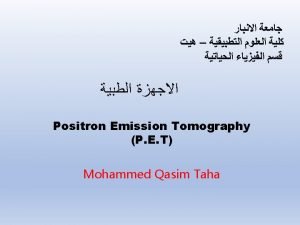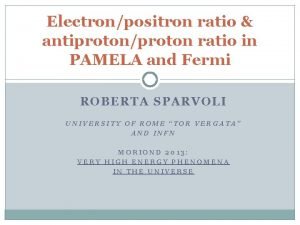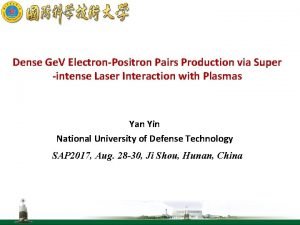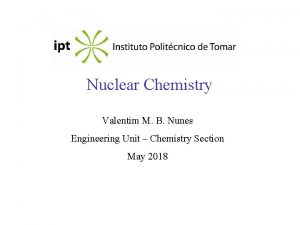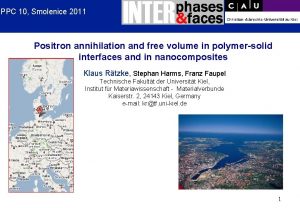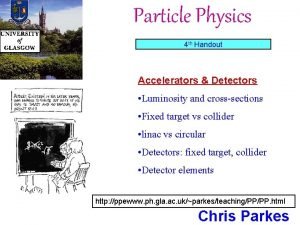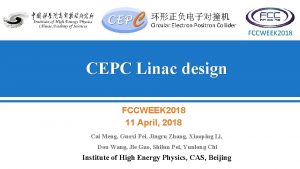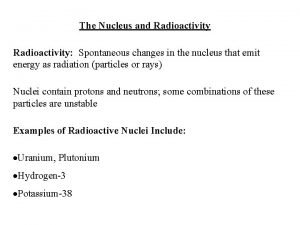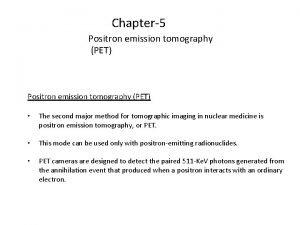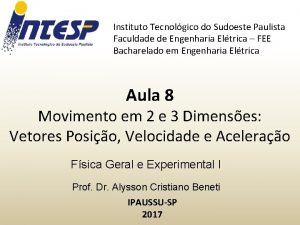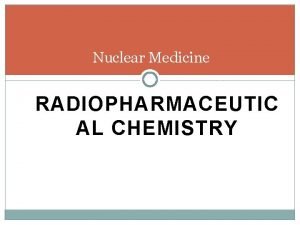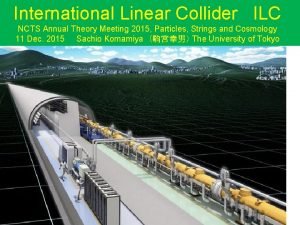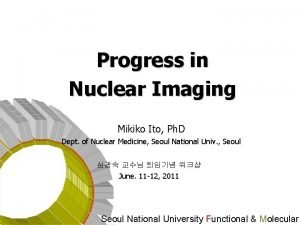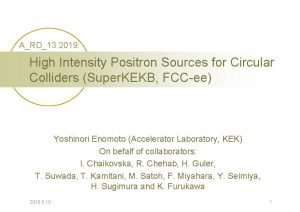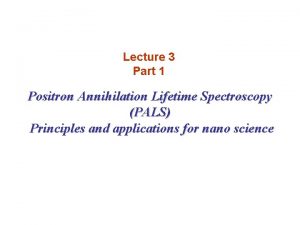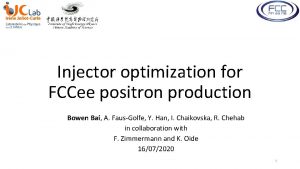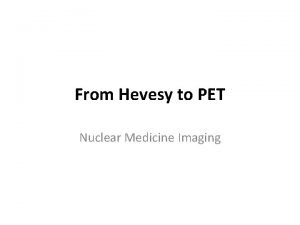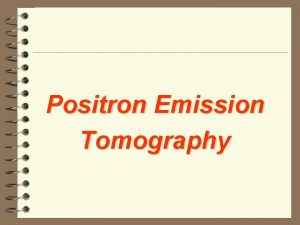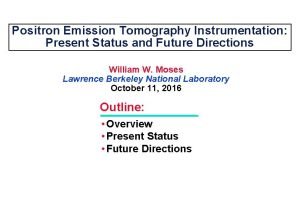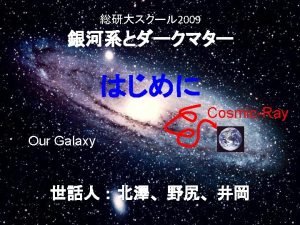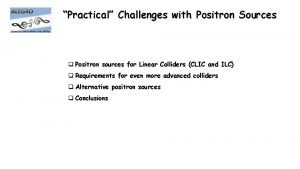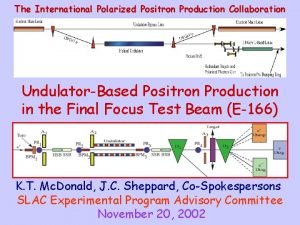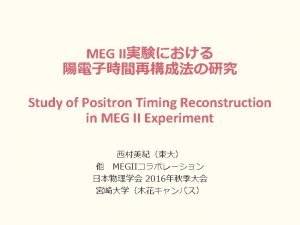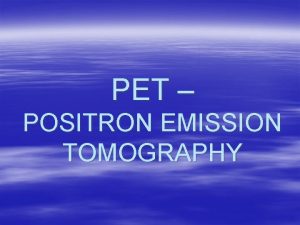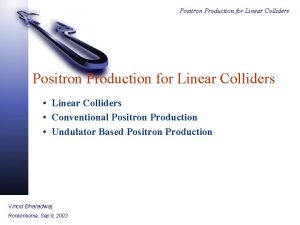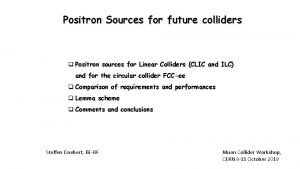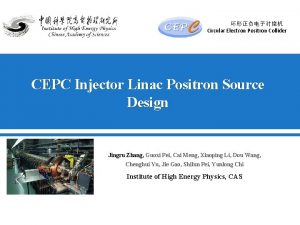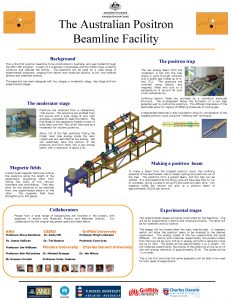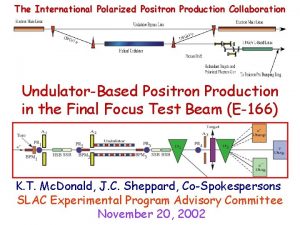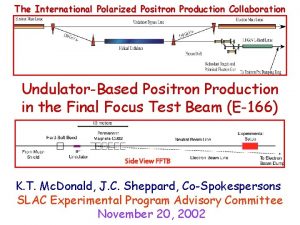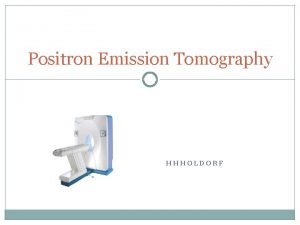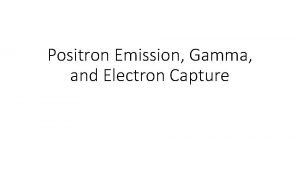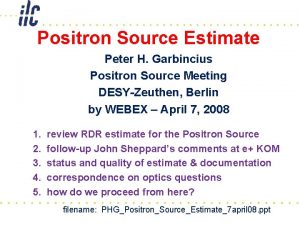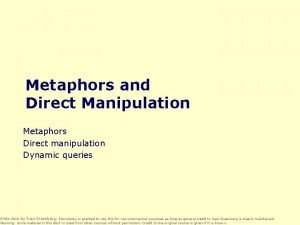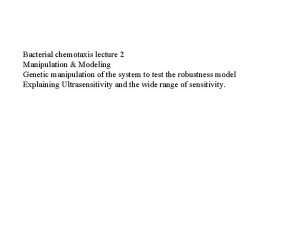CLIC RF manipulation for positron at CLIC Scenarios




















- Slides: 20

CLIC RF manipulation for positron at CLIC Scenarios studies on hybrid source Freddy Poirier 12/08/2010

HB source Efficiency snapshot Results here with old aperture structures Global On the way to be updated ACS only Efficiency (here): Nb e+ /nb e- at 200 Me. V, E>165 Me. V No polarisation of 4 w ag eek o s polarisation Up to Target As Compton source Compton 1. 3 Ge. V Compton 3 Ge. V Single 5 ip Up to Target e- ACS only g e+ Hybrid Source 5 Ge. V Sources scenarios (pol. and nonpol. ) being studied: - Hybrid source (CLIC baseline) - Compton source (see talks from I. Chaikoska)

HB source Hybrid Source Scenario (Baseline) Primary beam Linac for e- e- g/e+ Target Pre-injector Linac for e+ 5 Ge. V 2 GHz • • e-/g Target (crystal) 200 Me. V AMD 2 GHz Focus of the present study 5 Ge. V 2 m between crystal and target 10 mm target thickness Positron Bunch length at target exit= 500 mm

Present Studies • Capture and acceleration using Travelling Wave (TW) tanks. – 84 accelerating cells tanks + 2 couplers i. e. long cavity – Prior studies have used Standing Wave (SW) 6 cells cavities (see talk of A. Vivoli) • For Hybrid source (HB) – Scenarios with modification phase of first TW – Space charge limits – Additional Scenarios • Solenoid field (1 T) • Cavity within AMD

HB source 2 GHz TW tanks • 2 GHz • 84 accelerating cells constitute the TW tanks Typical cells dimension for the TW tanks – Note: 84 cells + 2 half cells for couplers within ASTRA – 2 p/3 operating mode • 4. 36 m long • 15 MV/m • Up to 5 tanks are used to accelerate e+ up to 200 Me. V First optimisation done on 15 mm iris (radius aperture) tanks but final results with 20 mm iris tanks Case with 4 cells 15 mm Typical electric field for the 4 cells cavity 2 p/3

HB source Capture Strategy Capture strategy of the first tank? Other tanks: full acceleration e+ g/e+ AMD target Solenoid TW tanks • Acceleration: Phase of the first tank tuned for use of maximum accelerating gradient for the first tank – 4 tanks are needed to reach ~200 Me. V • Deceleration: adapt the phase and gradient of the first tank to capture a maximum of positrons – 5 tanks are needed to reach ~200 Me. V

HB source Acceleration case at 18. 12 m (to reach ~200 Me. V) Population E (Me. V) Transverse distribution Population Z (m) E (Me. V) Z (m) X (m) 2388 positrons With cut at emin=165 Me. V Total Efficiency(200 Me. V, emin) 2388/6000= 0. 398

HB source Deceleration • First tank Phase = 280 o • Choice of gradient: Values at 22. 63 m (at ~200 Me. V) More positrons in the higher tail but tail further in z E (Me. V) 7 Mv/m 6 Mv/m 5 Mv/m Gradient (MV/m) Nb of positrons > 165 Me. V Nb of positrons > 185 Me. V 7 3227 2832 6 3193 Eff=0. 53 2929 Eff=0. 49 5 3147 2741 More positrons in lower tail but tail lower in energy Z (m)

HB source At 200 Me. V 691 e+ Z (m) Eff 200 Me. V = 0. 40 Deceleration case Energy (Me. V) Acceleration case 1317 e+ Z (m) Eff 200 Me. V = 0. 53 • For the deceleration case the efficiency* at 200 Me. V is higher than for the acceleration case • For further information: The value in red gives the number of positrons within the red dashed box *Eff 200 Me. V: Nb of particles entering target/ Nb of particles at exit of tank with energy greater than 165 Me. V

HB source 20 mm aperture New 2 GHz cavity and field provided by P. Lepercq Acceleration scenario Total yield=0. 9 Deceleration scenario Total yield=0. 95 Efficiency >165 Me. V=4621/6000= 0. 77 Efficiency >165 Me. V=5335/6000= 0. 89 (was 0. 4 for 15 mm aperture) (was 0. 53 for 15 mm aperture) This is the big advantage of the deceleration technique

HB source HB: Acceleration scenario Impact of space charge At 200 Me. V No space charge -10% level Negligible space charge effect to be expected Charge per macro-particles (n. C): Cmp=Ne+i x qe+ / ( 1 e-9 x Ne+s Charge x 250 Ne+i: initial nb of e+ Ne+s: simulated nb of e+ 3. 75 10 37. 5 375 Expected level of charge for HB x 109 e- In order to have a 10% level impact on the result, the e- charge has to be multiplied by 250. We are far from this with the present CLIC values.

HB source Impact of space charge • Acceleration scenario: – The use of space charge imply -3. 6% e+ at 200 Me. V. – With the present e- charge, we are at ~2. 5 102 lower than a 10% effect • Deceleration scenario: – The impact is -4. 6%. – With the present e- charge, we are at 102 lower than a 10% effect The impact of space charge is here of the order of less than 5% The difference from acceleration to deceleration is noticeable but the level is not detrimental in both case

Additional Studies on the capture with hybrid source • Additional scenario: – 1) An accelerating field within the Adiabatic Matching Device (AMD) – 2) Increase of the magnetic field surrounding the TW Accelerating section. Traditionally it is fixed at 0. 5 T. eg e+ g/e+ target AMD 4 cells cavity Solenoid TW tanks

HB source Additional Scenarios Acceleration scenarios 20 mm nominal case Case (AMD 6 T 0. 5 T and no cavity inside the AMD, but AMD inner radius=15 mm) e+ g/e+ target AMD 4 cells cavity Solenoid TW tanks

HB source Conclusion • 2 scenarios studied: – Acceleration and deceleration – Very interesting scenario is deceleration • Further optimisation (on lattice) for capture can be done • No major impact from space charge foreseen in both scenarios • Additional scenarios are also studied (booster within the AMD and higher solenoid field) which shows good potentials Perspectives • What about power consumption (TW/SW)? – The choice of TW/SW is not done yet. It will highly depends on the power consumption. – Though if TW are in use for acceleration between 200 Me. V up to DR then it is an attractive choice. – Review of dimension should be done (2 GHz 1 GHz? ) • The results need to be sent to the bunch compressor and check the effective yield there

More Slides

Compton source Compton Scenario target e- e+ Laser Pulse length=1. 5 mm ll=1064 um Laser pulse energy=0. 1 J x 5 1. 3 Ge. V esze-=600 mm szl>sze 2 o sz = 600 mm

Compton source Distributions at ~200 Me. V Acceleration case (18. 12 m) 1255 e+ 1. 3 Ge. V, 5 IP Deceleration case (22. 63 m) 2138 e+ This value is used for the efficiency calculation Red box: de=10 Me. V, dz=5 mm

HB source Impact of space charge • The space charge is considered traditionally low because: – Large transverse size of the beam at exit of AMD – High enough energy (The positrons have an average energy > 5 Me. V so quite relativistic) – Previous studies with Parmela simulation have shown an impact of space charge of the order of 1 % on the result • Are we far from any effect due to Space charge? – What is the limit wrt to the charge of the bunch. i. e. if we increase the charge of the bunch at the exit of the AMD will there be a noticeable impact? – What happen to the space charge limit if we do deceleration?

HB source The CLIC CDR yield hypothesis Target e+/e. Pre-accelerator 10 109 e- Yield e+/e- = 0. 7 PDR 7 109 e+ We are simulating 6000 e- (macro-particles), representing 10 109 e- i. e. the charge per simulated particle is 2. 7 10 -4 n. C. PDR: Pre-Damping Ring CDR values
 Positron emission
Positron emission Cirelli
Cirelli Positron vs electron
Positron vs electron Alpha particle symbol
Alpha particle symbol Positron yacht
Positron yacht Positron vs proton
Positron vs proton Positron
Positron Cobalt-60 beta decay equation
Cobalt-60 beta decay equation Positron symbol
Positron symbol Um pósitron sofre um deslocamento
Um pósitron sofre um deslocamento Positron emission tomography
Positron emission tomography Annual theory meeting
Annual theory meeting Positron emission tomography
Positron emission tomography Positron
Positron Gas separation
Gas separation Positron
Positron Researchgate
Researchgate Positron emission tomography
Positron emission tomography Positron emission
Positron emission Positron emission tomography
Positron emission tomography Kyssande vind analys
Kyssande vind analys
